
Model Airplane Contests
The little ones take engineering, too...

Join Us on Facebook
Model Airplane Contests

Over the past 8 years, we have developed a wealth information about model airplanes during the "Air Age". On November 25, 2009 we organized this information into smaller pages that will load quickly. We split the material into four segments, corresponding to the four boxes or "buttons" below. If you came in from a search engine looking for something very specific, click here for the Analytical Index that will enable you to find a specific topic.
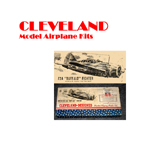
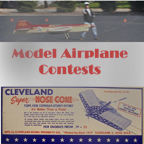
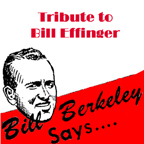
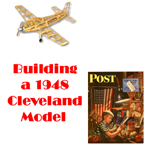
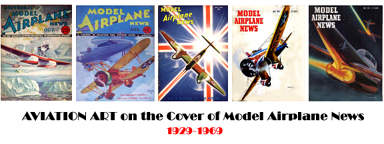
Click to look at all the covers of Model Airplane News from 1929-1969.
For those of you who don't like buttons, go to the analytical index to find just what you're looking for.
- Competition Kits Playboy and Condor
- Joe Elgin
- Competition Rules
- Playboy - Example of [old] FAI Class C
- Eaglet - Example of [old] FAI Class D
- Condor - Example of [old] FAI Class E
- Non-Scale Conrol-line Models
This is part of a general Retro Lifestyle/Swing Dancing website. We have a Guide to 1940s Treasures and a Swing Dance Calendar for Washington DC.. Please feel free to Contact Us if you'd like to comment on the golden age of balsa wood models.
Non-Scale Competition Models Playboy and Condor
Here are two Cleveland kits that Joe Elgin designed for Motorized Free Flight (Class "C" ) and Free Glider (Class "E"). But first, a little background.
Background 1: Joe Elgin
No discussion of Cleveland Kits is complete without mentioning Joe Elgin. He designed the Playboy, a Free Flight gas-powered model with an 80-inch wingspan, which was introduced in 1940. He also designed the Condor, a free-flight glider. He only worked for the company for only a year before pursuing a career as a lithographer, although he continued to make models and win international competitions.
During World War II, he served with the Army Air Forces in Europe as a navigator on a B-17. He was wounded and captured after his aircraft was shot down on his 19th mission over Germany. During his 16 months in German prison camps,he managed to build simple model planes, He cut wood (not balsa) into thin strips, scraped glue from furniture and used rubber thread from suspenders for power. A model was built that flew outside the compound. Guards were reportedly cooperative and did the retrieval.
After the war, he returned to his job at the Photo Litho Plate Co. and resumed competing at model air meets. In the early 1950s, he won a national championship and participated with various flight teams, including a group representing the United States that placed first in an international meet held in England in 1953. Elgin received the Academy of Model Aeronautics Pioneer Award in 1998 and was honored at the Society of Antique Modelers Championship in 1999.
He was an amateur photographer, who entered his back-and-white photos in competitions at the Cleveland Museum of Art. He also was a cartoonist, whose depictions of wartime experiences were published in the book "Behind Barbed Wire."
Background 2: Model Airplane Competition
The Fédération Aéronautique Internationale is the World governing body for all sorts of aircraft competition. The CIAM, or the International Aeromodelling Commission governs model aircraft competition. The FAI website goes into considerable detail about these events and you may download the FAI Rules here.
As we discuss Joe's two designs, you should know that free-flight means that the aircraft has no form of external control, such as control lines or radio. This is the oldest form of model airplane competition as aircraft of this type have been flown for over two centuries, long before humans flew. These planes are designed to be inherently stable in flight; if disturbed by a gust of wind or a thermal up-current they will return automatically to stable flight. For this reason most free flight aircraft are not replicas of larger planes. Their stability is achieved by a combination of design and trim, - the relationship between centre of gravity, wing and tailplane incidence and rudder setting. Because they have a low ratio of weight to wing area, free-flight aircraft fly very slowly. Most of them glide at little more than walking pace and few weigh more than 500 grams. Usually the sole object in free-flight is flight duration, and one of the sport’s fascinations and challenges is to design the most efficient aircraft within the various competition limits on such parameters as minimum weight, maximum wing area and motive power. It is solely a stopwatch, rather than any judge’s opinion, that decides the resultThe Playboy - Example of FAI Class "C"
The FAI defines Class C as: " model aircraft in which the energy is provided by a piston type motor and in which lift is generated by aerodynamic forces acting on surfaces remaining fixed in flight, except for changes of cambero r incidence. (i.e. no helicopters) Models with variable geometry or area must comply with the specifications when the surfaces are in minimum and maximum extended mode. (i.e planes with small wings that unfold to become big wings)"
In general, the size of the engine is severely limited to about 0.05-0.35 cubic inch displacement. No exhaust extensions whatsoever are allowed to prevent some sort of jet-like contraption. The plane must meet minimum weight requirements that are keyed to the displacement of the motor (to prevent a giant engine in a tiny airframe). The fuel supply must be such that the motor only runs for a short time (usually five seconds). Spark/glow plug engines must use a standard fuel ( 80% methanol, 20% castor or synthetic oil.) Fuel for compression ignition (diesel)motors is not restricted, although before each attempt for an official flight the fuel tank must be washed out with standard formula fuel.
Elgin's Playboy is an excelent example of a Class "C" competition model:
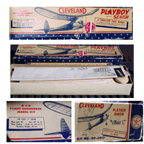

The Cleveland Playboy
Click to Enlarge
You can buy the plans for the Playboy on the Cleveland Website right now.
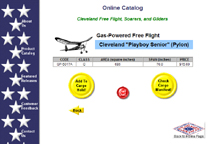
Playboy on the Cleveland Website
Click to Enlarge
Eaglet - Example of [old] FAI Class "D"
At the time that Cleveland kits were being manufactured, secondary (towed) gliders were in FAI Class "D" today, they are in Class "H" althought the definition remains the same: " A model aircraft which is not provided with a propulsion device and in which lift is generated by aerodynamic forces acting on surfaces remaining fixed in flight, except for changes in camber or incidence. Models with variable geometry or area must comply with the specification when the surfaces are in minimum and maximum extended mode.. the maximum length of the towline is 50 meters (about 150 feet).. the model must weigh at least 220 grams (about 6 ounces)...the wingspan area may not exceed 279 sq. in (a wing with 5" chord can be at max 56 inches long)"
Class "D" gliders got very high and flew for a long time. The Cleveland "Eglet" is advertised as flying for "hours." It's 48 inch wingspan would place it well within the competitive range.
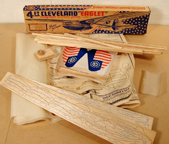
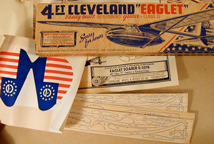
The Cleveland Eaglet
Click to Enlarge
You can buy the plans for the Eaglet on the Cleveland Website right now.
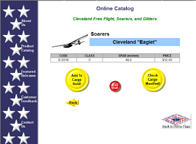
Eaglet at the Cleveland Site
Click to Enlarge
The Condor - Example of FAI Class "E"
The FAI defines Class E as: " aircraft not provided with a propulsion device and in which lift is generated by aerodynamic forces acting on surfaces that remain fixed in flight, except for changes of camber or incidence. (i.e. a glider) The model can be equipped with a steering device, but it may not be controlled by the competitor during flight." This type of model uses a variety of timing devices such as springs, clockwork and fuses to activate a mechanism that operates control surfaces to prevent stalling or to offset diving. The modeler is free to equip the glider with anything he wants, but the weight of such devices severely impacts performance. generally, these models have a very large wingspen.
Elgin's Condor is a good example of a Class "E" competition model:
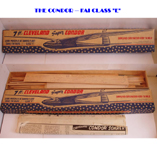
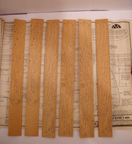

The Cleveland Condor

The Cleveland Mile Flyer "Polish Valor"
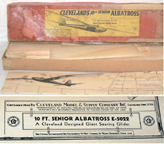
The Cleveland Albatross
Click to Enlarge
This type of kit would appeal mainly to those with a fairly large workspace. In general, these planes were made with detachable wings that would make it possible to transport the behemoth in a car.



Condor, Polish Valor, and Albatross at the Cleveland Site
Click to Enlarge
You can buy the plans and patterns that will enable you to make these models right now. Click Here to go to the exact location on the Cleveland Website to get them.
Non-Scale Conrol-line Models
The "Nose Cone" and "Super Nose Cone" were "Combat Models" Two persons would fly these control-line planes standing at the center of the same circle. The planes would have 6-10 foot ribbons on the back. The goal was to see how much ribbon that you could cut (with the propellor) of the other guy's plane in a fixed time period (e.g. two minutes) "Combat" planes were almost always "flying wings" -- you didn't want to give your opponent a long fuselage to chew on. Generally, these planes were powered by the biggest engine that you could put on them. All flying wings have to be kept moving quickly in order to avoid stalling. The "WHATZIT" had a tailplane giving it alittle more stability than most combat planes. This provided a lot more maneuverability and stall-resistance at the expense of speed.



Cleveland Control-line Model Nose Cone, Super Nose Cone, and WHATZIT
Click to Enlarge and Rotate
Apparently, the Cleveland Company no longer sells the plans and patterns for these subjects.
Counter for the Entire Site (not just this page..)
Home | About Lindy | 1940s Collectibles | Upcoming Events | Vintage Clothing
The Guide - Establishments - Travel - Accessories
Music | Links | Photo Gallery | Extras | Contact